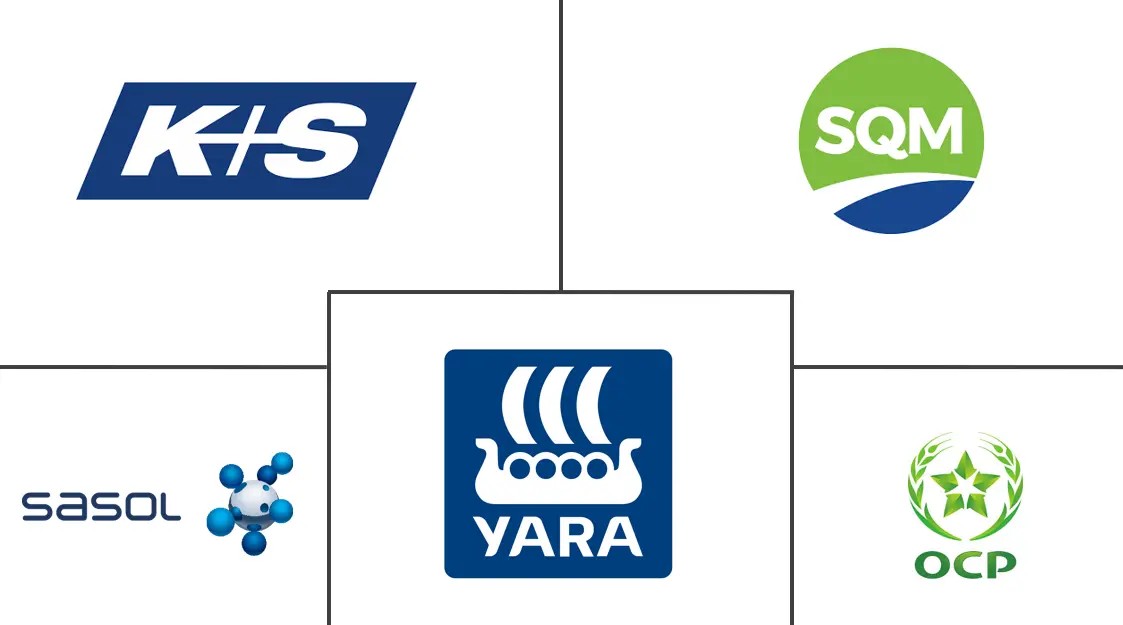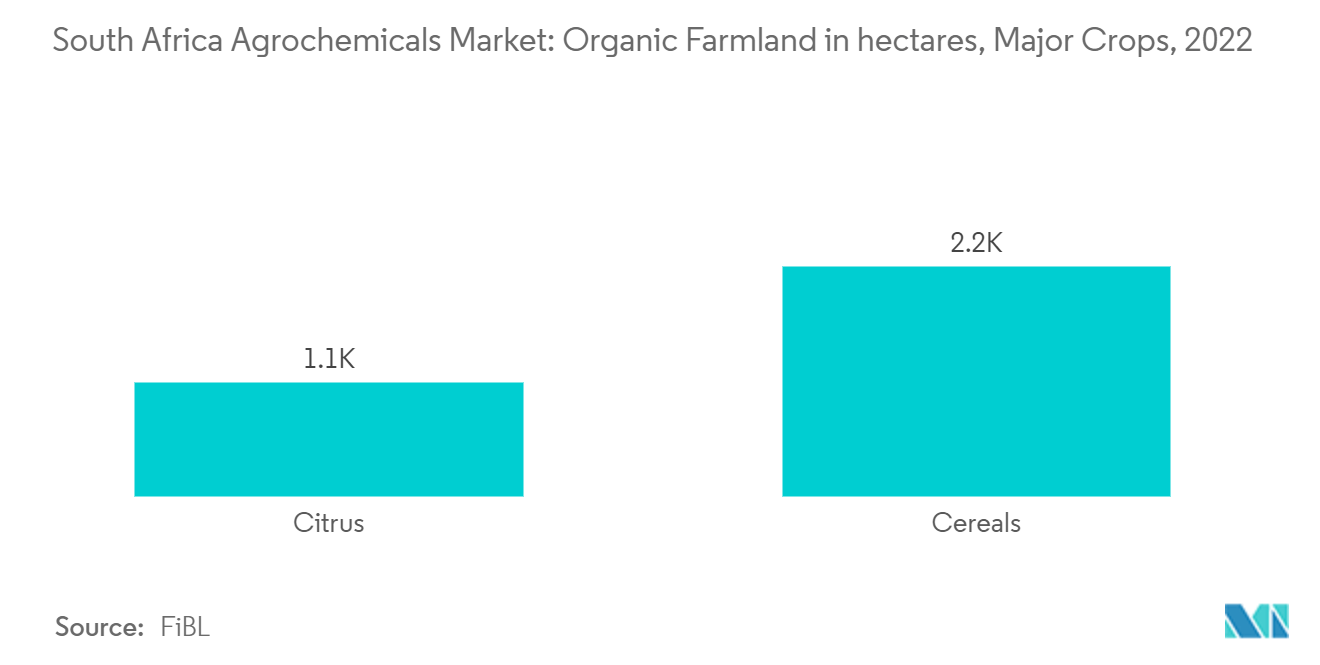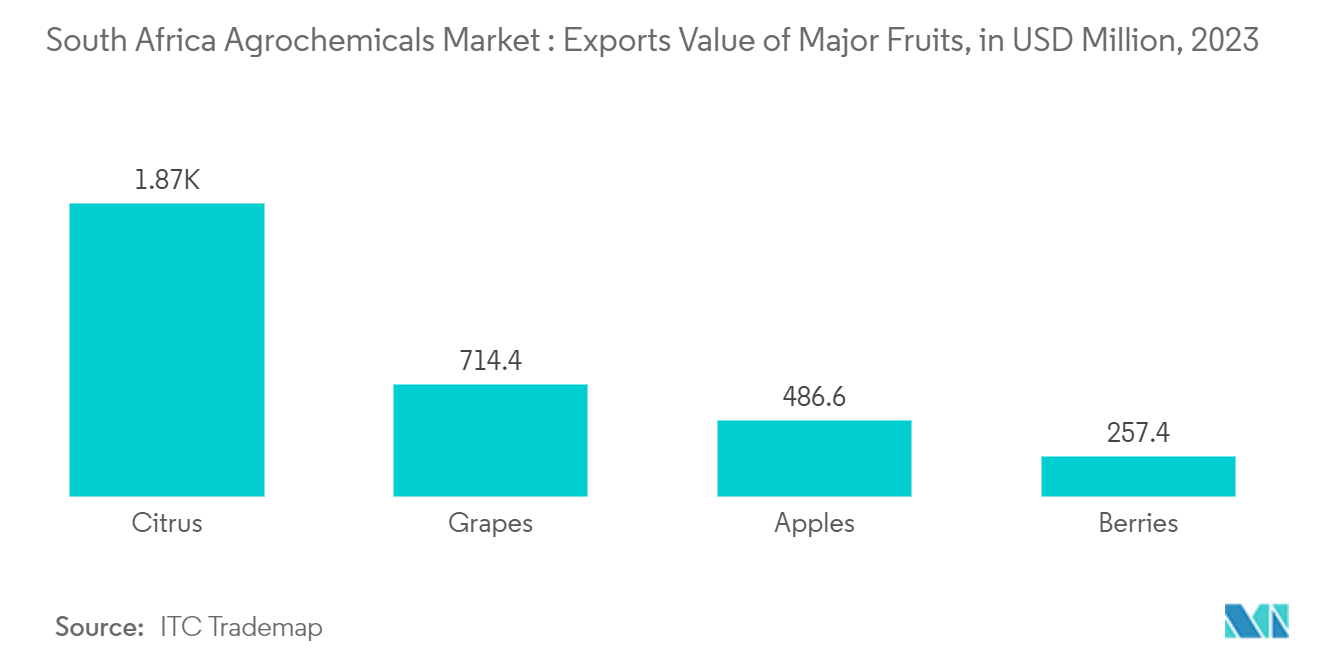South Africa Agrochemicals Market Size

| Study Period | 2019 - 2029 |
| Base Year For Estimation | 2023 |
| Market Size (2024) | USD 1.27 Billion |
| Market Size (2029) | USD 1.53 Billion |
| CAGR (2024 - 2029) | 3.90 % |
| Market Concentration | Low |
Major Players
*Disclaimer: Major Players sorted in no particular order |
South Africa Agrochemicals Market Analysis
The South Africa Agrochemicals Market size is estimated at USD 1.27 billion in 2024, and is expected to reach USD 1.53 billion by 2029, growing at a CAGR of 3.9% during the forecast period (2024-2029).
- As Africa's largest crop protection market, South Africa caters to a diverse range of farmers. These farmers operate across multiple sectors, including row crops, horticulture, citrus, nuts, and vines, spanning deciduous, subtropical, and forestry markets. Data from South Africa's Ministry of Agriculture, Land Reform, and Rural Development indicates that gross income from agricultural products hit USD 23 billion in 2022, a rise from USD 20.2 billion in 2021, translating to a 15.2% growth. This surge was largely driven by a 27.8% increase in income from field crops and a 5.8% rise in horticultural products. Such robust growth in the agricultural industry is significantly bolstering the agrochemicals market in South Africa.
- Over the past two decades, South Africa has witnessed a decline in the land area utilized for agriculture despite its expansive territory. This trend has intensified the push for enhanced production efficiency, subsequently driving up the demand for agrochemicals. With the economy on the rise, farmers are increasingly recognizing the crucial role of agrochemicals. The potential embrace of integrated farming practices stands to amplify this market. Consequently, the quest for efficiency, underscored by agrochemicals, remains a dominant force propelling market demand.
- Fertilizer prices across Africa diverge significantly from global rates, underscoring supply chain challenges intensified by the Russia-Ukraine conflict. South Africa's reliance on Russia for ammonium nitrate, a key ingredient in fertilizer production, poses challenges. The ongoing conflict is also affecting South Africa's fruit exports, notably citrus shipments to Russia. As growers seek alternative markets, this dynamic presents a constraint on the growth of the fertilizer segment.
South Africa Agrochemicals Market Trends
Increasing Demand for Bio-based Agrochemicals
- South Africa's export portfolio prominently features citrus fruits, including oranges, lemons, acid limes, grapefruits, and, to a lesser extent, tangerines. Data from The Research Institute of Organic Agriculture FiBL reveals that in 2022, organic cereals occupied 2.2 thousand hectares, while citrus fruits were cultivated on 1.1 thousand hectares. As a major supplier of fresh fruit to the European Union, South Africa set a record by shipping 18,863 metric tons of citrus fruits. With the country's robust export potential in organic produce targeting international markets, a notable increase in the consumption of bio-based agrochemicals is on a surge.
- South Africa has a burgeoning opportunity for bio-based crop protection products, especially those without residues. This is of paramount importance for export markets. The scope encompasses traditional crop protection solutions, biological products, and bio-stimulants. Notably, crop protection companies are channeling investments into these biological products. The biological products outperform conventional chemical products, especially in the export crop arena. Also, tightening environmental regulations are poised to influence the herbicide and insecticide markets. Producers increasingly prioritize sustainable pest control, adopting integrated pest management systems and programs, which bodes well for market growth.
- As chemical fertilizer prices continue to surge, more individual farmers are pivoting toward biofertilizers. In 2023, a farmer from Tsolo in the Eastern Cape crafted an economical biofertilizer, targeting local farmers struggling with high fertilizer expenses. This innovative biofertilizer is formulated using a mix of four native mycorrhizal fungi species. The key ingredient, mycorrhizal fungi, combines activated carbon from biochar, serving as its carrier. This potent duo boosts the plant's ability to absorb and make the most of soil nutrients and water. Such advancements are poised to introduce novel products in the fertilizer segment.

Rising Exports of Fruits and Vegetables to Drive Production
- In 2023, South Africa's agricultural industry achieved remarkable export milestones. According to Trade Map data, exports of fruits and vegetables surged to a record USD 4.55 billion, with fruits constituting over 99% of the total. Dominant exports included citrus, maize, apples, pears, nuts, grapes, berries, and avocados. Both increased volumes and rising prices drove this surge in export activity. Notably, the increase in export prices for South African fruits could stimulate heightened production and a surge in demand for agrochemicals.
- Exports were strategically diversified across several key markets. In 2023, the African continent led the charge, representing 38% of South Africa's agricultural export value. Asia followed as the second-largest market, accounting for 28%, trailed by the European Union at 19%. The Americas secured the fourth spot with 6%, while the remaining 9% was distributed to other global markets. The United Kingdom stood out in the 'Rest of the World' segment, accounting for 7% of total exports.
- South Africa stands out as a top global producer and exporter of grapes. As per ITC Trademap, the nation's grape exports reached a valuation of USD 714 million. However, grape crops in South Africa face challenges, notably from downy mildew. Commercial vineyards regularly implement fungicide spray programs to combat diseases like powdery mildew and Botrytis bunch rot.
- Due to increasing exports, the country is ramping up its production. This surge in production is expected to bolster the agrochemicals market, given the essential role in sustaining these production levels.

South Africa Agrochemicals Industry Overview
The South African agrochemicals market is fragmented, with many international and domestic players operating. The major players in the South African agrochemical market include Sociedad Química y Minera de Chile (SQM), OCP Group, Sasol Limited, Yara International, and K+S AG. These prominent players are expanding their positions in the country to have a wide-reaching consumer base for their agrochemical products. Further, key players are coming up with new innovative products that cater to the needs of the growers in the region.
South Africa Agrochemicals Market Leaders
-
Sasol Limited
-
OCP Group
-
Yara International ASA
-
Sociedad Química y Minera de Chile (SQM)
-
K+S AG
*Disclaimer: Major Players sorted in no particular order

South Africa Agrochemicals Market News
- May 2024: The African Union Commission was dedicated to strengthening the Africa Fertilizer Financing Mechanism to enhance food production. This commitment will enable the mechanism to invest in technologies that improve crop yields, initiatives that promote soil health, and infrastructure improvements. Such investments ensure better fertilizer availability and market access for farmers throughout Africa.
- December 2023: Bayer unveiled its new fungicide seed treatment, EverGol Energy, in South Africa, with availability set for farmers in 2024. This treatment targets both Fusarium spp. and Pythium spp. in maize and soybean crops.
- January 2023: K+S agreed to acquire a 75% stake in the fertilizer division of Industrial Commodities Holdings (Pty) Ltd (ICH), a trading firm based in South Africa. Following the signing of the agreement, the newly acquired entity will function under the name Fertiva (Pty) Ltd. This strategic move aims to bolster and broaden K+S's distribution reach in South Africa and East Africa.
South Africa Agrochemical Market Report - Table of Contents
1. INTRODUCTION
- 1.1 Study Assumptions and Market Definition
- 1.2 Scope of the Study
2. RESEARCH METHODOLOGY
3. EXECUTIVE SUMMARY
4. MARKET DYNAMICS
- 4.1 Market Overview
- 4.2 Market Drivers
- 4.3 Market Restraints
-
4.4 Industry Attractiveness - Porter's Five Forces Analysis
- 4.4.1 Bargaining Power of Suppliers
- 4.4.2 Bargaining Power of Buyers/Consumers
- 4.4.3 Threat of New Entrants
- 4.4.4 Threat of Substitute Products
- 4.4.5 Intensity of Competitive Rivalry
5. MARKET SEGMENTATION
-
5.1 Type
- 5.1.1 Fertilizers
- 5.1.2 Pesticides
- 5.1.3 Adjuvants
- 5.1.4 Plant Growth Regulators
-
5.2 Application
- 5.2.1 Grains and Cereals
- 5.2.2 Oil seeds
- 5.2.3 Fruits and Vegetables
- 5.2.4 Fruits and Vegetables
- 5.2.5 Other Applications (Plantation, Turf, and Ornamentals and Grass)
6. COMPETITIVE LANDSCAPE
- 6.1 Most Adopted Strategies
- 6.2 Market Share Analysis
-
6.3 Company Profiles
- 6.3.1 Bayer CropScience AG
- 6.3.2 BASF SE
- 6.3.3 Nutrien Ltd
- 6.3.4 Sociedad Química y Minera de Chile (SQM)
- 6.3.5 Yara International ASA
- 6.3.6 OCP Group
- 6.3.7 FMC Corporation
- 6.3.8 Sasol Limited
- 6.3.9 Corteva Agriscience
- 6.3.10 Sumitomo Corporation (Philagro SA)
- 6.3.11 Syngenta AG
- 6.3.12 K+S AG
- *List Not Exhaustive
7. MARKET OPPORTUNITIES AND FUTURE TRENDS
** Subject To AvailablitySouth Africa Agrochemicals Industry Segmentation
Agrochemicals are commercially produced chemicals or organic compounds used in farming for crop protection and nutrition. The South African agrochemicals market is segmented by type (fertilizers, pesticides, adjuvants, and plant growth regulators) and application (grains and cereals, oilseeds, fruits and vegetables, and other applications (plantation, turf, and ornamentals and grass)). The report offers market sizing in terms of values in USD.
| Type | Fertilizers |
| Pesticides | |
| Adjuvants | |
| Plant Growth Regulators | |
| Application | Grains and Cereals |
| Oil seeds | |
| Fruits and Vegetables | |
| Fruits and Vegetables | |
| Other Applications (Plantation, Turf, and Ornamentals and Grass) |
South Africa Agrochemical Market Research FAQs
How big is the South Africa Agrochemicals Market?
The South Africa Agrochemicals Market size is expected to reach USD 1.27 billion in 2024 and grow at a CAGR of 3.9% to reach USD 1.53 billion by 2029.
What is the current South Africa Agrochemicals Market size?
In 2024, the South Africa Agrochemicals Market size is expected to reach USD 1.27 billion.
Who are the key players in South Africa Agrochemicals Market?
Sasol Limited, OCP Group, Yara International ASA, Sociedad Química y Minera de Chile (SQM) and K+S AG are the major companies operating in the South Africa Agrochemicals Market.
What years does this South Africa Agrochemicals Market cover, and what was the market size in 2023?
In 2023, the South Africa Agrochemicals Market size was estimated at USD 1.22 billion. The report covers the South Africa Agrochemicals Market historical market size for years: 2019, 2020, 2021, 2022 and 2023. The report also forecasts the South Africa Agrochemicals Market size for years: 2024, 2025, 2026, 2027, 2028 and 2029.
Agrochemicals in South Africa Industry Report
The South Africa Agrochemicals Industry is a dynamic market segmented by type, including fertilizers, pesticides, adjuvants, and plant growth regulators. The application sectors are diverse, covering crop-based applications such as grains and cereals, oilseeds, and fruits and vegetables, as well as non-crop-based applications like turf and ornamental grass.
The market size of the South Africa Agrochemicals Industry is substantial, contributing significantly to the global market. The industry outlook is positive, with a steady growth rate anticipated over the forecast period. The market share and industry analysis indicate a competitive landscape with several key players dominating the market.
A comprehensive market analysis reveals that the industry is driven by factors such as increasing demand for food production and the need for efficient pest control solutions. The industry analysis further details the market trends and the role of agrochemicals in enhancing crop yield and quality.
The market outlook is promising, supported by industry reports that provide detailed insights into market segmentation and market value. The industry forecast suggests continued growth, driven by technological advancements and increased adoption of agrochemicals in farming practices.
Industry research highlights the importance of market data in understanding the market dynamics and making informed decisions. Market growth is expected to be fueled by innovations in product formulations and the introduction of eco-friendly agrochemicals.
The market overview offers a detailed report example, showcasing the market predictions and market review. The industry size and industry statistics provide a clear picture of the market's current state and future potential. Industry trends indicate a shift towards sustainable agricultural practices, influencing market leaders to invest in research and development.
The report pdf available for download offers a comprehensive analysis of the South Africa Agrochemicals Industry, including market segmentation and market value. Research companies play a crucial role in providing industry information and insights, helping stakeholders navigate the market effectively.
Overall, the South Africa Agrochemicals Industry is poised for significant growth, supported by a robust industry outlook and favorable market conditions. The market forecast and market predictions underscore the potential for continued expansion and innovation in this vital sector.



